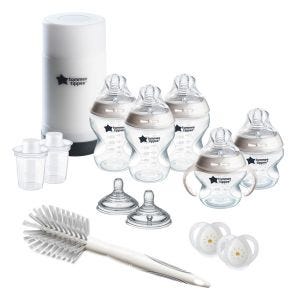
This is a demo store. No orders will be fulfilled.
Subscription orders can be cancelled at anytime. Free delivery on all subsequent subscription orders. Find out more about subscriptions.
They’re easy and fuss free
Your products are automatically sent to you
You save up to 10% when you sign up for a subscription
You can cancel at any time
Watching a baby grow and develop is a very exciting time. One of the key developmental milestones that parents look forward to is the moment when their baby learns to roll over independently.
Let's run through when babies commonly learn to roll over, how you can encourage them to roll, and how to keep them safe once they're able to roll over on their own.
All babies are different and will develop at their own pace. However, it's typical that at around five months, a baby will begin to be able to roll over slightly, rock on their tummy from side to side, and use their arms to push themselves up. Some may roll independently earlier, and others might take a little longer - each baby is unique.
Little ones usually master the art of rolling from their stomach to their back first, daily supervised tummy time helps with this. They'll then learn to roll from their back onto their stomach at around eight months.
Tummy time means letting your baby lie on their stomach while they're wide awake. It's a great way to help build the strength and coordination needed for rolling over and eventually sitting and crawling. It also lets them explore the different ways that their head, limbs, and neck can move.
Some babies don't enjoy tummy time at first, but you can start from birth by lying them on your chest when you're both awake for a few minutes a day. Gradually work up to about 20 minutes per day of tummy time on a blanket on the floor once your baby is used to the idea.
For their safety, parents must never leave their baby unattended during tummy time.
Play and exploration are key to a baby's physical and mental development, and you can help by...
Once your baby has learned to roll over independently, they're going to be more mobile. So, it's important to start thinking about ways to keep them safe as they continue to grow and develop. To keep them out of harm's way...
It's also important to maintain a safe sleep routine and stop swaddling your little one as soon as they show signs of being able to roll over on their own.
When your baby has learned to roll over on their own during tummy time, there's a chance that they'll start rolling over in the night, too.
This isn't anything to worry about. Now that your little one has developed the strength and mobility to roll over onto their front, they'll also be much less likely to get stuck in a sleeping position which will affect their breathing.
Even when they can roll over independently, it's still recommended that parents continue to put their baby down to sleep on their back. You can also position them with one arm extended out if you're concerned. That way, they'll be less likely to flip over onto their stomach during the night.
All babies develop at their own pace and it's important to be patient with your little one and enjoy every special milestone.
But if you're concerned about their development at any stage, it's best to seek advice early from your doctor or healthcare visitor, especially if your little one gets to six months of age and hasn't started sitting, crawling, scooting, or reaching for things just yet.
Around the same time as rolling over, babies start getting stronger and (with a little help from you) begin working their way towards other key motor developmental steps. These include sitting and crawling, pulling themselves up, standing and eventually walking (or toddling) on their own two feet!